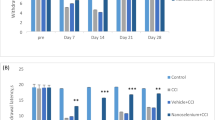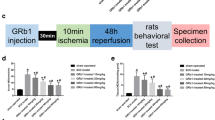Abstract
Selenium is considered as a trace element that plays antioxidant role in the body. So, the aim of this study was to evaluate the effect of selenium on ameliorating of sciatic nerve ischemia-reperfusion injury. Eighty (80) adult male Wistar rats weighing 250–300 g were used. They were divided into 10 groups (n = 8). Then, femoral vessels were obstructed by using 4/0 silk and splitknot techniques. After 3-h ischemia for all the groups, reperfusion was applied for different periods: 3, 7, 14, and 28 days. In half of each experimental group, 0.2 mg/kg selenium was injected intraperitoneally, coinciding with ischemia. After reperfusion, according to the grouping, rats were killed by using high dose of anesthetic drug and then sciatic nerve was removed and fixed. Then, tissue samples were processed and subsequently stained with hematoxylin-eosin, apoptosis, and immunohistochemistry stains. On the third day of reperfusion, the amount of TNF-α as an inflammatory marker of ischemia-reperfusion acute phase increased. On the seventh day of reperfusion, the amount of NF-кB as an apoptotic index and infiltration of mast cells increased in the tissue as a result of development of inflammation. But, on the 14th day of reperfusion, the amount of NF-кB as an apoptotic index decreased to the lowest amount. On the 28th day of reperfusion, the amount of TNF-α as an inflammatory marker decreased to its lowest level. Prescription of selenium concurrent with development of ischemia can reduce the damage caused by sciatic nerve ischemia-reperfusion.





Similar content being viewed by others
References
Abramson SB (1990) Mechanisms of action of nonsteroidal anti-inflammatory drugs and therapeutic considerations. Bull Hosp Joint Dis Orthop Inst 50(2):107–115
Acker CG, Flick R, Shapiro R, Scantlebury VP, Jordan ML, Vivas C, Greenberg A, Johnson JP (2002) Thyroid hormone in the treatment of post-transplant acute tubular necrosis (ATN). Am J Transplant Off J Am Soc Transplant Am Soc Transplant Surg 2(1):57–61
Acker CG, Singh AR, Flick RP, Bernardini J, Greenberg A, Johnson JP (2000) A trial of thyroxine in acute renal failure. Kidney Int 57(1):293–298. doi:10.1046/j.1523-1755.2000.00827.x
Alipour M, Gholami MR, Jafari Anarkooli I, Sohrabi D, Tajki J, Pourheidar M (2011) Intraperitoneal aminoguanidine improves sciatic nerve ischemia-reperfusion injury in male Sprague-dawley rats. Cell Mol Neurobiol 31(5):765–773. doi:10.1007/s10571-011-9682-5
Gholami MR, Abolhassani F, Pasbakhsh P, Akbari M, Sobhani A, Eshraghian MR, Kamalian N, Amoli FA, Dehpour AR, Sohrabi D (2008) The effects of simvastatin on ischemia-reperfusion injury of sciatic nerve in adult rats. Eur J Pharmacol 590(1–3):111–114. doi:10.1016/j.ejphar.2008.05.050
Gholami MR, Abolhassani F, Pasbakhsh P, Akbari M, Sobhani A, Sohrabi D, Mehrania K (2007) The effects of simvastatin on functional recovery of rat reperfused sciatic nerve. Pak J Biol Sci: PJBS 10(23):4256–4260
Reiter RJ, Carneiro RC, Oh CS (1997) Melatonin in relation to cellular antioxidative defense mechanisms. Hormone and metabolic research = Hormon- und Stoffwechselforschung = Hormones et metabolisme 29 (8):363–372. doi:10.1055/s-2007-979057
Zollman PJ, Awad O, Schmelzer JD, Low PA (1991) Effect of ischemia and reperfusion in vivo on energy metabolism of rat sciatic-tibial and caudal nerves. Exp Neurol 114(3):315–320
Iida H, Schmelzer JD, Schmeichel AM, Wang Y, Low PA (2003) Peripheral nerve ischemia: reperfusion injury and fiber regeneration. Exp Neurol 184(2):997–1002. doi:10.1016/S0014-4886(03)00385-6
Gray C, Nukada H, Jackson DM, McMorran PD, Wu A, Ma F (2003) Neuroprotective effects of nitrone radical scavenger S-PBN on reperfusion nerve injury in rats. Brain Res 982(2):179–185
Erbil G, Ozbal S, Sonmez U, Pekcetin C, Tugyan K, Bagriyanik A, Ozogul C (2008) Neuroprotective effects of selenium and Ginkgo biloba extract (EGb761) against ischemia and reperfusion injury in rat brain. Neurosciences 13(3):233–238
Ozbal S, Erbil G, Kocdor H, Tugyan K, Pekcetin C, Ozogul C (2008) The effects of selenium against cerebral ischemia-reperfusion injury in rats. Neurosci Lett 438(3):265–269. doi:10.1016/j.neulet.2008.03.091
Gholami M, Zendedel A, Khanipour khayat Z, Ghanad K, Nazari A, Pirhadi A (2015) Selenium effect on ischemia-reperfusion injury of gastrocnemius muscle in adult rats. Biol Trace Elem Res 164(2):205–211. doi:10.1007/s12011-014-0218-y
AL-Rasheed NM, Attia HA, Mohamed RA, Al-Rasheed NM, Al-Amin MA (2014) Preventive effects of selenium yeast, chromium Picolinate, zinc sulfate and their combination on oxidative stress, inflammation, impaired angiogenesis and Atherogenesis in myocardial infarction in rats. Journal of Pharmacy & Pharmaceutical Sciences 16(5):848–867
Ostadalova I, Vobecky M, Chvojkova Z, Mikova D, Hampl V, Wilhelm J, Ostadal B (2007) Selenium protects the immature rat heart against ischemia/reperfusion injury. Mol Cell Biochem 300(1–2):259–267. doi:10.1007/s11010-006-9391-4
Zendedel ADS, Ahmadvand H, Ghanadi K, Gholami M (2015) Effects of selenium on antioxidant activity and recovery from sciatic nerve ischemia–reperfusion in adult rats. Zahedan. J Res Med Sci 17(12):1–6
Yao HD, Wu Q, Zhang ZW, Zhang JL, Li S, Huang JQ, Ren FZ, Xu SW, Wang XL, Lei XG (2013) Gene expression of endoplasmic reticulum resident selenoproteins correlates with apoptosis in various muscles of se-deficient chicks. J Nutr 143(5):613–619. doi:10.3945/jn.112.172395
Yao HD, Wu Q, Zhang ZW, Li S, Wang XL, Lei XG, Xu SW (2013) Selenoprotein W serves as an antioxidant in chicken myoblasts. Biochim Biophys Acta 1830(4):3112–3120. doi:10.1016/j.bbagen.2013.01.007
Swardfager W, Lanctot K, Rothenburg L, Wong A, Cappell J, Herrmann N (2010) A meta-analysis of cytokines in Alzheimer’s disease. Biol Psychiatry 68(10):930–941. doi:10.1016/j.biopsych.2010.06.012
Gholami M, Khayat ZK, Anbari K, Obidavi Z, Varzi A, Boroujeni MB, Alipour M, Niapoor A, Gharravi AM (2016) Quercetin ameliorates peripheral nerve ischemia-reperfusion injury through the NF-kappa B pathway. Anat Sci Int. doi:10.1007/s12565-016-0336-z
Saray A, Apan A, Kisa U (2003) Free radical-induced damage in experimental peripheral nerve injection injury. J Reconstr Microsurg 19(6):401–406. doi:10.1055/s-2003-42637
Mitsui Y, Schmelzer JD, Zollman PJ, Mitsui M, Kihara M, Low PA (1999) Hypothermic neuroprotection of peripheral nerve of rats from ischemia-reperfusion injury: intraischemic vs. reperfusion hypothermia. Brain Res 827(1–2):63–69
Wang Y, Kawamura N, Schmelzer JD, Schmeichel AM, Low PA (2008) Decreased peripheral nerve damage after ischemia-reperfusion injury in mice lacking TNF-alpha. J Neurol Sci 267(1–2):107–111. doi:10.1016/j.jns.2007.10.004
Turan B, Saini HK, Zhang M, Prajapati D, Elimban V, Dhalla NS (2005) Selenium improves cardiac function by attenuating the activation of NF-κB due to ischemia-reperfusion injury. Antioxid Redox Signal 7(9–10):1388–1397
Joseph J, Loscalzo J (2013) Selenistasis: epistatic effects of selenium on cardiovascular phenotype. Nutrients 5(2):340–358. doi:10.3390/nu5020340
Lee YJ, Kim JE, Kwak MH, Go J, Yang SY, Kwon HS, Kim BC, Kim JM, Hwang DY (2014) Selenium treatment significantly inhibits tumor necrosis factor-alpha-induced cell death and tau hyperphosphorylation in neuroblastoma cells. Mol Med Rep 10(4):1869–1874. doi:10.3892/mmr.2014.2442
Turan B (2010) Role of antioxidants in redox regulation of diabetic cardiovascular complications. Curr Pharm Biotechnol 11(8):819–836
Bozkurt S, Arikan DC, Kurutas EB, Sayar H, Okumus M, Coskun A, Bakan V (2012) Selenium has a protective effect on ischemia/reperfusion injury in a rat ovary model: biochemical and histopathologic evaluation. J Pediatr Surg 47(9):1735–1741. doi:10.1016/j.jpedsurg.2012.03.053
Heyland DK (2007) Selenium supplementation in critically ill patients: can too much of a good thing be a bad thing? Crit Care 11(4):153. doi:10.1186/cc5975
Turker Y, Naziroglu M, Gumral N, Celik O, Saygin M, Comlekci S, Flores-Arce M (2011) Selenium and L-carnitine reduce oxidative stress in the heart of rat induced by 2.45-GHz radiation from wireless devices. Biol Trace Elem Res 143(3):1640–1650. doi:10.1007/s12011-011-8994-0
Turker O, Karapolat I (2008) There is immunological benefit of selenium treatment in autoimmune thyroiditis. Thyroid: Off J Am Thyroid Assoc 18(6):671–672 . doi:10.1089/thy.2007.0391author reply 673-674
Acknowledgments
This study was approved in the Lorestan University of Medical Sciences. Special thanks to Lorestan University of Medical Sciences for the financial support, Khorramabad, Iran. The authors thank the head and staff of Razi Herbal Drugs Research Center of Lorestan Medical University.
Author information
Authors and Affiliations
Corresponding author
Ethics declarations
Conflict of Interest
The authors declare that they have no conflict of interests.
Rights and permissions
About this article
Cite this article
Zendedel, A., Gharibi, Z., Anbari, K. et al. Selenium Ameliorate Peripheral Nerve Ischemic-Reperfusion Injury via Decreased TNF-α. Biol Trace Elem Res 176, 328–337 (2017). https://doi.org/10.1007/s12011-016-0836-7
Received:
Accepted:
Published:
Issue Date:
DOI: https://doi.org/10.1007/s12011-016-0836-7




